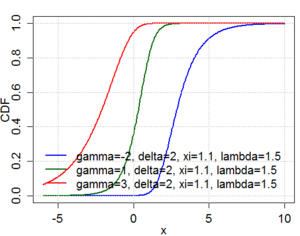Johnson's SU-distribution
This article needs attention from an expert in statistics. The specific problem is: completion to reasonable standard for probability distributions. (November 2012) |
|
Probability density function  | |||
|
Cumulative distribution function  | |||
| Parameters | (real) | ||
|---|---|---|---|
| Support | |||
| CDF | |||
| Mean | |||
| Median | |||
| Variance | |||
| Skewness | |||
Excess kurtosis |
| ||
The Johnson's SU-distribution is a four-parameter family of probability distributions first investigated by N. L. Johnson in 1949.[1][2] Johnson proposed it as a transformation of the normal distribution:[1]
where .
Generation of random variables
Let U be a
where Φ is the cumulative distribution function of the normal distribution.
Johnson's SB-distribution
N. L. Johnson[1] firstly proposes the transformation :
where .
Johnson's SB random variables can be generated from U as follows:
The SB-distribution is convenient to Platykurtic distributions (Kurtosis). To simulate SU, sample of code for its density and cumulative distribution function is available here
Applications
Johnson's -distribution has been used successfully to model asset returns for portfolio management.[3] This comes as a superior alternative to using the Normal distribution to model asset returns. An R package, JSUparameters, was developed in 2021 to aid in the estimation of the parameters of the best-fitting Johnson's -distribution for a given dataset. Johnson distributions are also sometimes used in
An alternative to the Johnson system of distributions is the quantile-parameterized distributions (QPDs). QPDs can provide greater shape flexibility than the Johnson system. Instead of fitting moments, QPDs are typically fit to empirical CDF data with linear least squares.
Johnson's -distribution is also used in the modelling of the
References
- ^ JSTOR 2332539.
- JSTOR 2332669.
- ^ Tsai, Cindy Sin-Yi (2011). "The Real World is Not Normal" (PDF). Morningstar Alternative Investments Observer.
- ^ As an example, see: LHCb Collaboration (2022). "Precise determination of the – oscillation frequency". Nature Physics. 18: 1–5. .
Further reading
- Hill, I. D.; Hill, R.; Holder, R. L. (1976). "Algorithm AS 99: Fitting Johnson Curves by Moments". Journal of the Royal Statistical Society. Series C (Applied Statistics). 25 (2).
- Jones, M. C.; Pewsey, A. (2009). "Sinh-arcsinh distributions" (PDF). Biometrika. 96 (4): 761. )
- Tuenter, Hans J. H. (November 2001). "An algorithm to determine the parameters of SU-curves in the Johnson system of probability distributions by moment matching". The Journal of Statistical Computation and Simulation. 70 (4): 325–347. Zbl 1098.62523.





















